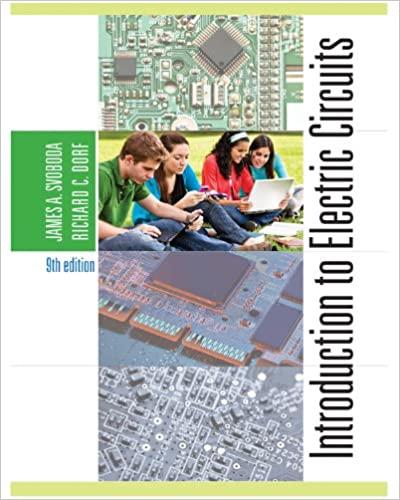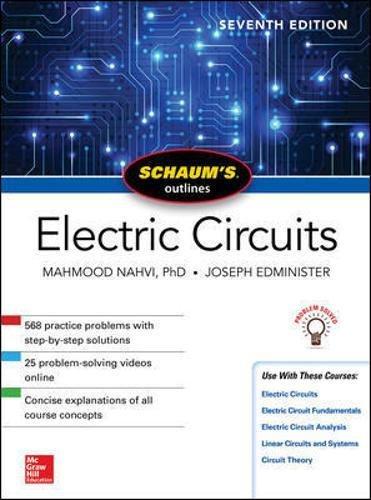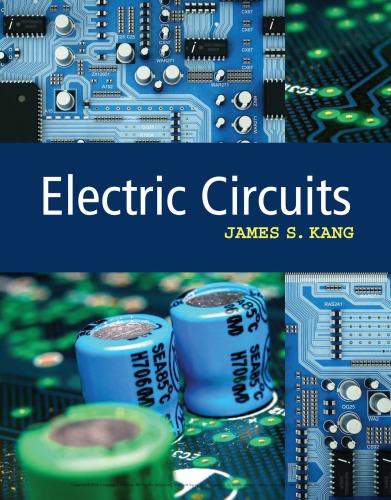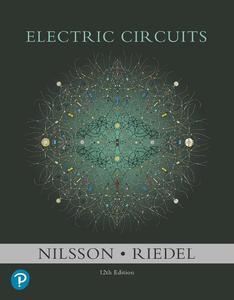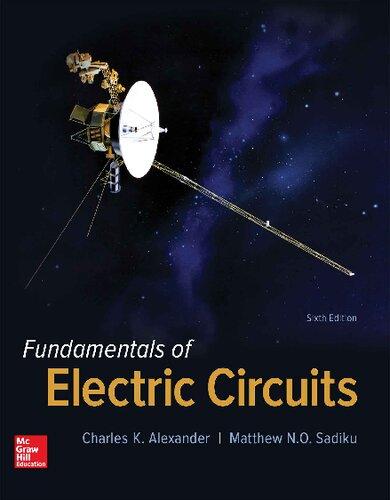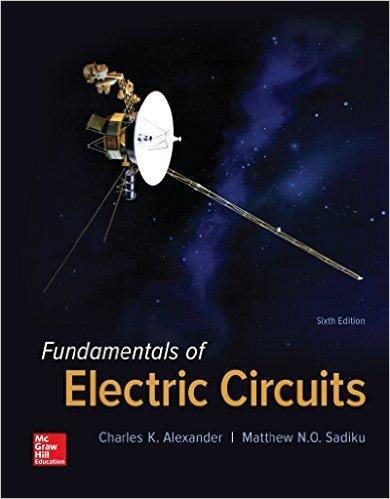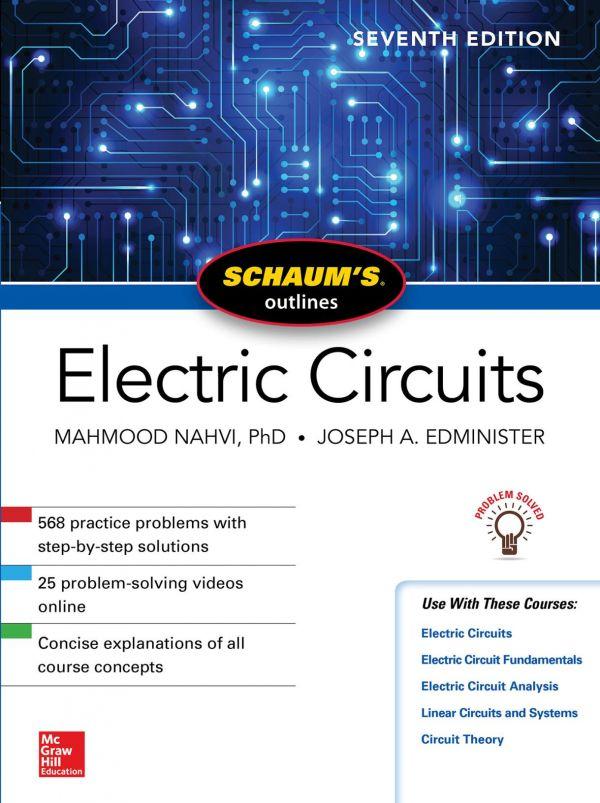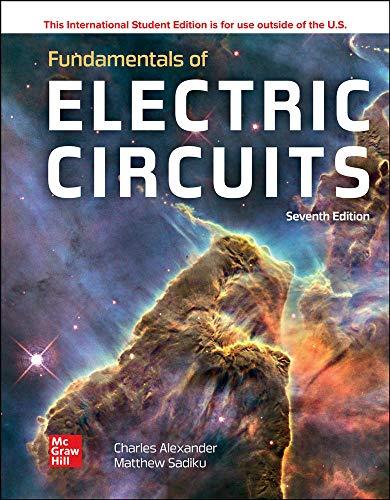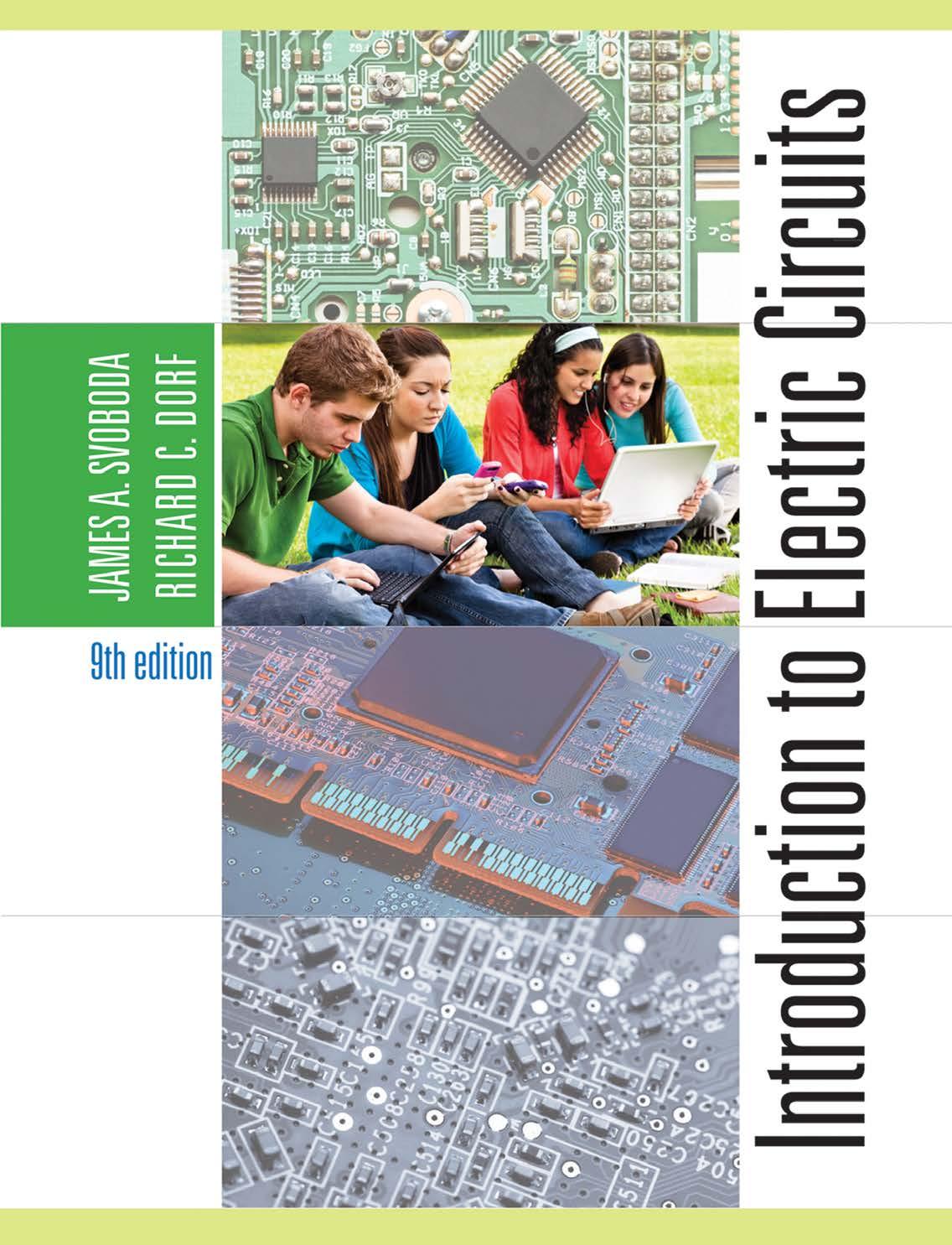Introduction to Electric Circuits, 9th Edition Visit to download the full and correct content document: https://ebookmass.com/product/introduction-to-electric-circuits-9th-edition/
More products digital (pdf, epub, mobi) instant download maybe you interests ...
Electric Circuits 7th Edition Mahmood Nahvi
https://ebookmass.com/product/electric-circuits-7th-editionmahmood-nahvi/
Electric Circuits 1st Edition James S. Kang
https://ebookmass.com/product/electric-circuits-1st-editionjames-s-kang/
Electric Circuits, 12e 12th Edition James Nilsson
https://ebookmass.com/product/electric-circuits-12e-12th-editionjames-nilsson/
Fundamentals of Electric Circuits 6th Edition Charles Alexander
https://ebookmass.com/product/fundamentals-of-electriccircuits-6th-edition-charles-alexander/
eTextbook 978-0078028229
Fundamentals of Electric Circuits 6th Edition
https://ebookmass.com/product/etextbook-978-0078028229fundamentals-of-electric-circuits-6th-edition/
Fundamentals of electric circuits Sixth Edition
Alexander Charles K
https://ebookmass.com/product/fundamentals-of-electric-circuitssixth-edition-alexander-charles-k/
Schaum’s Outline of Electric Circuits 7th Edition
Mahmood Nahvi
https://ebookmass.com/product/schaums-outline-of-electriccircuits-7th-edition-mahmood-nahvi/
Fundamentals of Electric Circuits (International Student Edition) Charles K. Alexander
https://ebookmass.com/product/fundamentals-of-electric-circuitsinternational-student-edition-charles-k-alexander/
Introduction to Clinical Pharmacology 9th Edition https://ebookmass.com/product/introduction-to-clinicalpharmacology-9th-edition/
andMATLABareusedthroughoutthetexttosolvevariouscircuitanalysisanddesignproblems.For example,PSpiceisusedinChapter5to findaTheveninequivalentcircuitandinChapter15torepresent circuitinputsandoutputsasFourierseries.MATLABisfrequentlyusedtoobtainplotsofcircuitinputs andoutputsthathelpustoseewhatourequationsaretellingus.MALABalsohelpsuswithsomelong andtediousarithmetic.Forexample,inChapter10,MATLABhelpsusdothecomplexarithmeticthat wemustdoinordertoanalyzeaccircuits,andinChapter14,MATLABhelpswiththepartialfraction requiredto fi ndinverseLaplacetransforms.
Ofcourse,there’smoretousingPSpiceandMATLABthansimplyrunningtheprograms.We payparticularattentiontointerpretingtheoutputofthesecomputerprogramsandcheckingittomake surethatitiscorrect.Frequently,thisisdoneinthesectioncalled “HowCanWeCheck...?” thatis includedineverychapter.Forexample,Section8.9showshowtointerpretandcheckaPSpice “TransientResponse,” andSection13.7showshowtointerpretandcheckafrequencyresponse producedusingMATLABorPSpice.
DesignExamples,aProblem-SolvingMethod,and “HowCanWeCheck...?”
Sections Eachchapterconcludeswithadesignexamplethatusesthemethodsofthatchaptertosolveadesign problem.Aformal five-stepproblem-solvingmethodisintroducedinChapter1andthenusedineach ofthedesignexamples.Animportantstepintheproblem-solvingmethodrequiresyoutocheck yourresultstoverifythattheyarecorrect.Eachchapterincludesasectionentitled “HowCanWe Check...? ” thatillustrateshowthekindofresultsobtainedinthatchaptercanbecheckedtoensure correctness.
KeyEquationsandFormulas Youwill fi ndthatkeyequations,formulas,andimportantnoteshavebeencalledoutinashadedboxto helpyoupinpointcriticalinformation.
SummarizingTablesandFigures Theproceduresandmethodsdevelopedinthistexthavebeensummarizedincertainkeytablesand fi gures.Studentswill fi ndthesetobeanimportantproblem-solvingresource.
Table1.5-1.Thepassiveconvention.
Figure2.7-1andTable2.7-1.Dependentsources.
Table3.10-1.Seriesandparallelsources.
Table3.10-1.Seriesandparallelelements.Voltageandcurrentdivision.
Figure4.2-3.Nodevoltagesversuselementcurrentsandvoltages.
Figure4.5-4.Meshcurrentsversuselementcurrentsandvoltages.
Figures5.4-3and5.4-4.Théveninequivalentcircuits.
Figure6.3-1.Theidealopamp.
Figure6.5-1.Acatalogofpopularopampcircuits.
Table7.8-1.Capacitorsandinductors.
Table7.13-2.Seriesandparallelcapacitorsandinductors.
Table8.11-1.First-ordercircuits.
Tables9.13-1,2,and3.Second-ordercircuits.
Table10.5-1.VoltageandcurrentdivisionforACcircuits.
Table10.16-1.ACcircuitsinthefrequencydomain(phasorsandimpedances).
Table11.5-1.PowerformulasforACcircuits.
Tables11.13-1and11.13-2.Coupledinductorsandidealtransformers.
Table13.4-1.Resonantcircuits.
Tables14.2-1and14.2-2.Laplacetransformtables.
Table14.7-1.s-domainmodelsofcircuitelements.
Table15.4-1.Fourierseriesofselectedperiodicwaveforms.
IntroductiontoSignalProcessing Signalprocessingisanimportantapplicationofelectriccircuits.Thisbookintroducessignalprocessing intwoways.First,twosections(Sections6.6and7.9)describemethodstodesignelectriccircuitsthat implementalgebraicanddifferentialequations.Second,numerousexamplesandproblemsthroughout thisbookillustratesignalprocessing.Theinputandoutputsignalsofanelectriccircuitareexplicitly identi fiedineachoftheseexamplesandproblems.Theseexamplesandproblemsinvestigatethe relationshipbetweentheinputandoutputsignalsthatisimposedbythecircuit.
InteractiveExamplesandExercises Numerousexamplesthroughoutthisbookarelabeledasinteractiveexamples.Thislabelindicatesthat computerizedversionsofthatexampleareavailableatthetextbook’scompanionsite,www.wiley.com/ svoboda.Figure2illustratestherelationshipbetweenthetextbookexampleandthecomputerized exampleavailableontheWebsite.Figure2a showsanexamplefromChapter3.Theproblempresented bytheinteractiveexampleshowninFigure2b issimilartothetextbookexamplebutdifferentinseveral ways:
Thevaluesofthecircuitparametershavebeenrandomized. Theindependentanddependentsourcesmaybereversed. Thereferencedirectionofthemeasuredvoltagemaybereversed.
Adifferentquestionisasked.Here,thestudentisaskedtoworkthetextbookproblembackward, usingthemeasuredvoltagetodeterminethevalueofacircuitparameter.
Theinteractiveexampleposesaproblemandthenacceptsandcheckstheuser’sanswer.Studentsare providedwithimmediatefeedbackregardingthecorrectnessoftheirwork.Theinteractiveexample choosesparametervaluessomewhatrandomly,providingaseeminglyendlesssupplyofproblems.This pairingofasolutiontoaparticularproblemwithanendlesssupplyofsimilarproblemsisaneffective aidforlearningaboutelectriccircuits.
TheinteractiveexerciseshowninFigure2c considersasimilar,butdifferent,circuit.Likethe interactiveexample,theinteractiveexerciseposesaproblemandthenacceptsandcheckstheuser’s answer.Studentlearningisfurthersupportedbyextensivehelpintheformofworkedexample problems,availablefromwithintheinteractiveexercise,usingtheWorkedExamplebutton.
VariationsofthisproblemareobtainedusingtheNewProblembutton.Wecanpeekatthe answer,usingtheShowAnswerbutton.Theinteractiveexamplesandexercisesprovidehundredsof additionalpracticeproblemswithcountlessvariations,allwithanswersthatarecheckedimmediately bythecomputer.
SupplementsandWebSiteMaterial ThealmostubiquitoususeofcomputersandtheWebhaveprovidedanexcitingopportunitytorethink supplementarymaterial.Thesupplementsavailablehavebeengreatlyenhanced.
AdditionalstudentandinstructorresourcescanbefoundontheJohnWiley&Sonstextbook companionsiteatwww.wiley.com/college/svoboda.
measures a voltage in volts. What is the value of the resistance R in Ω?
ammeter measures a current in amps. What is the value of the current measured by the ammeter?
FIGURE2 (a)ThecircuitconsideredExample3.2-5.(b)Acorrespondinginteractiveexample.(c)Acorresponding interactiveexercise.
Student
InteractiveExamples
Theinteractiveexamplesandexercisesarepowerfulsupportresources forstudents.Theywerecreatedastoolstoassiststudentsinmasteringskillsandbuilding theircon fidence.TheexamplesselectedfromthetextandincludedontheWebgivestudents optionsfornavigatingthroughtheproblem.Theycanimmediatelyrequesttoseethesolutionor selectamoregradualapproachtohelp.Thentheycantrytheirhandatasimilarproblembysimply electingtochangethevaluesintheproblem.Bythetimestudentsattemptthehomework,theyhave builtthecon fidenceandskillstocompletetheirassignmentssuccessfully.It’savirtualhomework helper.
PSpiceforLinearCircuits ,availableforpurchase. WileyPLUS option.
Instructor
Solutionsmanual. PowerPointslides. WileyPLUS option.
WileyPLUS
PspiceforLinearCircuits isastudentsupplementavailableforpurchase.The PSpiceforLinear Circuits manualdescribesincarefuldetailhowtoincorporatethisvaluabletoolinsolvingproblems. Thismanualemphasizestheneedtoverifythecorrectnessofcomputeroutput.Noexampleis finished untilthesimulationresultshavebeencheckedtoensurethattheyarecorrect.
AcknowledgmentsandCommitmenttoAccuracy Wearegratefultomanypeoplewhoseeffortshavegoneintothemakingofthistextbook.Weare especiallygratefultoourExecutiveEditorDanielSayre,ExecutiveMarketingManagerChrisRueland MarketingAssistantMarissaCarrollfortheirsupportandenthusiasm.WearegratefultoTimLindner andKevinHolmofWileyandBruceHobartofLaserwordsMainefortheireffortsinproducingthis textbook.WewishtothankSeniorProductDesignerJennyWelter,ContentEditorWendyAshenberg, andEditorialAssistantJessKnechtfortheirsigni ficantcontributionstothisproject.
Weareparticularlygratefultotheteamofreviewerswhocheckedtheproblemsandsolutionsto ensuretheiraccuracy:
AccuracyCheckers KhalidAl-Olimat,OhioNorthern University
LisaAnneberg,Lawrence TechnologicalUniversity
HoraceGordon,UniversityofSouth Florida
LisimachosKondi,SUNY,Buffalo MichaelPolis,OaklandUniversity SannasiRamanan,RochesterInstitute ofTechnology
WilliamRobbins,UniversityofMinnesota JamesRowland,UniversityofKansas MikeShen,DukeUniversity ThyagarajanSrinivasan,Wilkes University
AaronStill,U.S.NavalAcademy HowardWeinert,JohnsHopkinsUniversity Xiao-BangXu,ClemsonUniversity JiannShiunYuan,Universityof CentralFlorida
Reviewers
RehabAbdel-Kader,GeorgiaSouthern University
SaidAhmed-Zaid,BoiseState University
FarzanAminian,TrinityUniversity
ConstantinApostoaia,Purdue UniversityCalumet
JonathonBagby,FloridaAtlanticUniversity
CarlottaBerry,TennesseeStateUniversity
KironBordoloi,UniversityofLouisville
MauroCaputi,HofstraUniversity
EdwardCollins,ClemsonUniversity
GlenDudevoir,U.S.MilitaryAcademy
MalikElbuluk,UniversityofAkron PrasadEnjeti,TexasA&MUniversity
AliEydgahi,UniversityofMaryland EasternShore
CarlosFigueroa,CabrilloCollege
WalidHubbi,NewJerseyInstituteofTechnology
BrianHuggins,BradleyUniversity
ChrisIanello,UniversityofCentralFlorida
SimoneJarzabek,ITTTechnicalInstitute
JamesKawamoto,MissionCollege
RasoolKenarangui,University ofTexasArlington
JumokeLadeji-Osias,MorganStateUniversity
MarkLau,UniversidaddelTurabo
SeyedMousavinezhad,Western MichiganUniversity
PhilipMunro,YoungstownStateUniversity
AhmadNa fisi,CaliforniaPolytechnicState University
ArnostNeugroschel,UniversityofFlorida TokunboOgunfunmi,SantaClaraUniversity
GaryPerks,CaliforniaPolytechnicState University,SanLuisObispo
OwePetersen,MilwaukeeSchoolofEngineering
RonPieper,UniversityofTexas,Tyler TeodoroRobles,MilwaukeeSchoolof Engineering
PeddaSannuti,RutgersUniversity
MarceloSimoes,ColoradoSchoolofMines
RalphTanner,WesternMichiganUniversity
TristanTayag,TexasChristianUniversity
Jean-ClaudeThomassian,Central MichiganUniversity
JohnVentura,ChristianBrothersUniversity AnnettevonJouanne, OregonStateUniversity
RaviWarrier,KetteringUniversity
GeraldWoel fl,MilwaukeeSchoolof Engineering
HewlonZimmer,U.S.Merchant MarineAcademy
CHAPTER4
MethodsofAnalysisofResistiveCircuits......................................................................................................114
4.1Introduction.........................................................................................................................114
4.2NodeVoltageAnalysisofCircuitswithCurrentSources....................................................115
4.3NodeVoltageAnalysisofCircuitswithCurrentandVoltageSources...............................121
4.4NodeVoltageAnalysiswithDependentSources................................................................126
4.5MeshCurrentAnalysiswithIndependentVoltageSources.................................................128
4.6MeshCurrentAnalysiswithCurrentandVoltageSources.................................................133
4.7MeshCurrentAnalysiswithDependentSources.................................................................137
4.8TheNodeVoltageMethodandMeshCurrentMethodCompared......................................139
4.9CircuitAnalysisUsingMATLAB.......................................................................................142
4.10UsingPSpicetoDetermineNodeVoltagesandMeshCurrents..........................................144
4.11HowCanWeCheck...?.................................................................................................146
4.12DesignExample PotentiometerAngleDisplay................................................................149
4.13Summary.............................................................................................................................152
CHAPTER5
5.4Thevenin’sTheorem............................................................................................................180
5.5Norton’sEquivalentCircuit.................................................................................................187
5.6MaximumPowerTransfer...................................................................................................191
5.7UsingMATLABtoDeterminetheTheveninEquivalentCircuit........................................194
5.8UsingPSpicetoDeterminetheTheveninEquivalentCircuit..............................................197
5.9HowCanWeCheck...?.................................................................................................200
6.4NodalAnalysisofCircuitsContainingIdealOperationalAmplifiers..................................223
6.5DesignUsingOperationalAmplifiers..................................................................................228
6.6OperationalAmplifi erCircuitsandLinearAlgebraicEquations.........................................233
6.7CharacteristicsofPracticalOperationalAmpli fiers.............................................................238
6.8AnalysisofOpAmpCircuitsUsingMATLAB..................................................................245
6.9UsingPSpicetoAnalyzeOpAmpCircuits.........................................................................247
6.10HowCanWeCheck...?.................................................................................................248
6.11DesignExample TransducerInterfaceCircuit..................................................................250
7.1Introduction.........................................................................................................................268
7.2Capacitors............................................................................................................................269
7.3EnergyStorageinaCapacitor.............................................................................................275
7.4SeriesandParallelCapacitors..............................................................................................278
7.5Inductors..............................................................................................................................280
7.6EnergyStorageinanInductor.............................................................................................285
7.7SeriesandParallelInductors................................................................................................287
7.8InitialConditionsofSwitchedCircuits................................................................................288
7.9OperationalAmpli fierCircuitsandLinearDifferentialEquations......................................292
7.10UsingMATLABtoPlotCapacitororInductorVoltageandCurrent..................................298
7.11HowCanWeCheck...?.................................................................................................300
7.12DesignExample
7.13Summary.............................................................................................................................304
8.5StabilityofFirst-OrderCircuits...........................................................................................340
8.6TheUnitStepSource...........................................................................................................342
8.7TheResponseofaFirst-OrderCircuittoaNonconstantSource.........................................346
8.8DifferentialOperators..........................................................................................................351
8.9UsingPSpicetoAnalyzeFirst-OrderCircuits.....................................................................352
9.1Introduction.........................................................................................................................378
9.2DifferentialEquationforCircuitswithTwoEnergyStorageElements...............................379
9.3SolutionoftheSecond-OrderDifferentialEquation
9.4NaturalResponseoftheUnforcedParallel
9.5NaturalResponseoftheCriticallyDampedUnforcedParallel
9.6NaturalResponseofanUnderdampedUnforcedParallel
9.7ForcedResponseofan
9.8CompleteResponseofan
11.11HowCanWeCheck...?.................................................................................................546
CHAPTER17
Two-PortandThree-PortNetworks.................................................................................................................840
17.1Introduction.........................................................................................................................840
17.2T-to-P TransformationandTwo-PortThree-TerminalNetworks.......................................841
17.3EquationsofTwo-PortNetworks........................................................................................843
17.4 Z and Y ParametersforaCircuitwithDependentSources...................................................846
17.5HybridandTransmissionParameters..................................................................................848
17.6RelationshipsBetweenTwo-PortParameters......................................................................850
17.7InterconnectionofTwo-PortNetworks...............................................................................852
17.8HowCanWeCheck...?.................................................................................................855
17.9DesignExample TransistorAmplifi er..............................................................................857
17.10Summary.............................................................................................................................859
APPENDIXA
APPENDIXB
APPENDIXC
CHAPTER1 ElectricCircuit Variables INTHISCHAPTER 1.1 Introduction
1.2 ElectricCircuits andCurrent
1.3 Systemsof Units
1.4 Voltage
Powerand Energy
CircuitAnalysis andDesign
HowCanWe Check...?
1.1 Introduction Summary Problems DesignProblems
Acircuitconsistsofelectricalelementsconnectedtogether.Engineersuseelectriccircuitstosolve problemsthatareimportanttomodernsociety.Inparticular:
1. Electriccircuitsareusedinthegeneration,transmission,andconsumptionofelectricpowerand energy.
2. Electriccircuitsareusedintheencoding,decoding,storage,retrieval,transmission,andprocessing ofinformation.
Inthischapter,wewilldothefollowing:
Representthecurrentandvoltageofanelec triccircuitelement,payingparticular attentiontothereferencedirectionofthecurrentandtothereferencedirectionorpolarityof thevoltage.
Calculatethepowerandenergysuppliedorreceivedbyacircuitelement.
Usethepassiveconventiontodeterminewhethertheproductofthecurrentand voltageofacircuitelementisthepowersuppliedbythatelementorthepowerreceivedby theelement.
Usescientificnotationtorepresentelectricalquantitieswithawiderangeofmagnitudes.
1.2 ElectricCircuitsandCurrent Theoutstandingcharacteristicsofelectric itywhencomparedwithotherpowersourcesareits mobilityand fl exibility.Electricalenerg ycanbemovedtoanypointalongacoupleofwiresand, dependingontheuser ’ srequirements,convertedtolight,heat,ormotion.
An electriccircuit orelectricnetworkisaninterconnectionofelectricalelementslinked togetherinaclosedpathsothatanelectriccurrentmay flowcontinuously.
2 1.ElectricCircuitVariables
Considerasimplecircuitconsistingoftwowell-knownelectricalelements,abatteryanda resistor,asshowninFigure1.2-1.Eachelementisrepresentedbythetwo-terminalelement showninFigure1.2-2.Elementsaresometimescalleddevices,andterminalsaresometimescalled nodes.
FIGURE1.2-1 Asimplecircuit.
FIGURE1.2-2 Ageneraltwo-terminalelectricalelement withterminalsaandb.
Chargemay flowinanelectriccircuit. Currentisthetimerateofchangeofchargepastagiven point.Chargeistheintrinsicpropertyofmatterresponsibleforelectricphenomena.Thequantityof charge q canbeexpressedintermsofthechargeononeelectron,whichis 1.602 10 19 coulombs. Thus, 1coulombisthechargeon6.24 1018 electrons.Thecurrentthroughaspeci fiedareais definedbytheelectricchargepassingthroughtheareaperunitoftime.Thus, q isdefi nedasthecharge expressedincoulombs(C).
Charge isthequantityofelectricityresponsibleforelectricphenomena.
Thenwecanexpresscurrentas
Theunitofcurrentistheampere(A);anampereis1coulombpersecond.
Current isthetimerateof flowofelectricchargepastagivenpoint.
Notethatthroughoutthischapterweusealowercaseletter,suchas q,todenoteavariablethatisa functionoftime, q(t).Weuseanuppercaseletter,suchas Q,torepresentaconstant.
The flowofcurrentisconventionallyrepresentedasa flowofpositivecharges.Thisconvention wasinitiatedbyBenjaminFranklin,the firstgreatAmericanelectricalscientist.Ofcourse,we nowknowthatcharge flowinmetalconductorsresultsfromelectronswithanegativecharge. Nevertheless,wewillconceiveofcurrentasthe flowofpositivecharge,accordingtoaccepted convention.
b a
i1 i2
FIGURE1.2-3 Current inacircuitelement.
Figure1.2-3showsthenotationthatweusetodescribeacurrent.Therearetwopartsto thisnotation:avalue(perhapsrepresentedbyavariablename)andanassigneddirection.Asa matterofvocabulary,wesaythatacurrentexists in or through anelement.Figure1.2-3shows thattherearetwowaystoassignthedirectionofthecurrentthroughanelement.Thecurrent i1 istherateof flowofelectricchargefromterminalatoterminalb.Ontheotherhand,the current i2 isthe flowofelectricchargefromterminalbtoterminala.Thecurrents i1 and i2 are
0 i I t FIGURE1.2-4 Adirectcurrentofmagnitude I
similarbutdifferent.Theyarethesamesizebuthavedifferentdirections.Therefore, i2 isthenegative of i1 and
i1 ¼ i2
Wealwaysassociateanarrowwithacurrenttodenoteitsdirection.Acompletedescriptionofcurrent requiresbothavalue(whichcanbepositiveornegative)andadirection(indicatedbyanarrow).
Ifthecurrent flowingthroughanelementisconstant,werepresentitbytheconstant I,asshownin Figure1.2-4.Aconstantcurrentiscalleda directcurrent (dc).
A directcurrent (dc)isacurrentofconstantmagnitude.
Atime-varyingcurrent i(t)cantakemanyforms,suchasaramp,asinusoid,oranexponential,as showninFigure1.2-5.Thesinusoidalcurrentiscalledan alternatingcurrent (ac).
FIGURE1.2-5 (a)Arampwithaslope M.(b)Asinusoid.(c)Anexponential. I isaconstant.Thecurrent i iszerofor t < 0.
Ifthecharge q isknown,thecurrent i isreadilyfoundusingEq.1.2-1.Alternatively,ifthecurrent i isknown,thecharge q isreadilycalculated.NotethatfromEq.1.2-1,weobtain
where q(0)isthechargeat t ¼ 0.
E XAMPLE 1.2-1 CurrentfromCharge
Findthecurrentinanelementwhenthechargeenteringtheelementis q ¼ 12t C
where t isthetimeinseconds.
Try it yourself in WileyPLUS 4 1.ElectricCircuitVariables
Solution
Recallthattheunitofchargeiscoulombs,C.Thenthecurrent,fromEq.1.2-1,is i ¼ dq dt ¼ 12A
wheretheunitofcurrentisamperes,A. E XAMPLE 1.2-2 ChargefromCurrent
Findthechargethathasenteredtheterminalofanelementfrom t ¼ 0sto t ¼ 3swhenthecurrententeringthe elementisasshowninFigure1.2-6. 1 0123 –1 2 3 4 i (A) t (s)
FIGURE1.2-6 CurrentwaveformforExample1.2-2.
Solution
FromFigure1.2-6,wecandescribe i(t)as
UsingEq.1.2-2,wehave
Alternatively,wenotethatintegrationof i(t)from t ¼ 0to t ¼ 3ssimplyrequiresthecalculationoftheareaunder thecurveshowninFigure1.2-6.Then,wehave
EXERCISE1.2-1
Findthechargethathasenteredanelementbytime t when i ¼ 8t 2 4 t A, t 0.Assume q( t) ¼ 0for t < 0.
Answer: qtðÞ¼ 8 3 t 3 2t 2 C
EXERCISE1.2-2
Thetotalchargethathasenteredacircuitelementis q(t) ¼ 4sin3t Cwhen t 0,and q(t) ¼ 0when t < 0.Determinethecurrentinthiscircuitelementfor t > 0.
Answer: itðÞ¼ d dt 4sin3t ¼ 12cos3t A
1.3 SystemsofUnits Inrepresentingacircuitanditselements,wemustdefineaconsistentsystemofunitsforthequantities occurringinthecircuit.Atthe1960meetingoftheGeneralConferenceofWeightsandMeasures,the representativesmodernizedthemetricsystemandcreatedtheSystemeInternationald’Unites, commonlycalledSIunits.
SI is SystemeInternationald’Unites ortheInternationalSystemofUnits.
Thefundamental,orbase,unitsofSIareshowninTable1.3-1.Symbolsforunitsthatrepresentproper (persons’)namesarecapitalized;theothersarenot.Periods arenotusedafterthesymbols,andthesymbolsdo nottakeonpluralforms.Thederivedunitsforother physicalquantitiesareobtainedbycombiningthe fundamentalunits.Table1.3-2showsthemorecommonderivedunitsalongwiththeirformulasintermsof thefundamentalunitsorprecedingderivedunits.Symbolsareshownfortheunitsthathavethem.
Table1.3-1 SIBaseUnits
Length meter m
Mass kilogram kg
Time second s
Electriccurrent ampere A
Thermodynamictemperature kelvin K
Amountofsubstance mole mol
Luminousintensity candela cd
Table1.3-2 DerivedUnitsinSI
QUANTITY
Acceleration linearmeterpersecondpersecond m/s2
linear meterpersecond
hertz
newton
pascal
Density kilogrampercubicmeter
joule
coulomb
Table1.3-3 SIPrefixes
Thebasicunitssuchaslengthinmeters(m),timeinseconds(s),andcurrentinamperes(A)can beusedtoobtainthederivedunits.Then,forexample,wehavetheunitforcharge(C)derivedfromthe productofcurrentandtime(A s).Thefundamentalunitforenergyisthejoule(J),whichisforcetimes distanceorN m.
ThegreatadvantageoftheSIsystemisthatitincorporatesadecimalsystemforrelatinglarger orsmallerquantitiestothebasicunit.Thepowersof10arerepresentedbystandardprefixesgivenin Table1.3-3.Anexampleofthecommonuseofaprefixisthecentimeter(cm),whichis0.01meter.
Thedecimalmultipliermustalwaysaccompanytheappropriateunitsandisneverwrittenbyitself. Thus,wemaywrite2500Was2.5kW.Similarly,wewrite0.012Aas12mA.
E XAMPLE 1.3-1 SIUnits Amassof150gramsexperiencesaforceof100newtons.Findtheenergyorworkexpendedifthemassmoves 10centimeters.Also, findthepowerifthemasscompletesitsmovein1millisecond.
Solution
Theenergyisfoundas
Notethatweusedthedistanceinunitsofmeters.Thepowerisfoundfrom
EXERCISE1.3-1 Whichofthethreecurrents,
islargest?
Answer: i3 islargest.
Voltage Thebasicvariablesinanelectricalcircuitarecurrentandvoltage.Thesevariables describethe fl owofchargethroughtheelementsofacircuitandtheenergyrequiredto causechargeto flow.Figure1.4-1showsthenotationweusetodescribeavoltage. Therearetwopartstothisnotation:avalue(perhapsrepresentedbyavariablename) andanassigneddirection.Thevalueofavoltagemaybepositiveornegative.The directionofavoltageisgivenbyitspolarities(þ, ).Asamatterofvocabulary,wesay thatavoltageexists across anelement.Figure1.4-1showsthattherearetwowaysto labelthevoltageacrossanelement.Thevoltage vba isproportionaltotheworkrequiredtomovea positivechargefromterminalatoterminalb.Ontheotherhand,thevoltage vab isproportionaltothe workrequiredtomoveapositivechargefromterminalbtoterminala.Wesometimesread vba as “the voltageatterminalbwithrespecttoterminala.” Similarly, vab canbereadas “thevoltageatterminala withrespecttoterminalb.” Alternatively,wesometimessaythat vba isthevoltagedropfromterminala toterminalb.Thevoltages vab and vba aresimilarbutdifferent.Theyhavethesamemagnitudebut differentpolarities.Thismeansthat vab ¼ vba
FIGURE1.4-1 Voltage acrossacircuitelement.
Whenconsidering vba,terminalbiscalledthe “þ terminal ” andterminalaiscalledthe “ terminal.” On theotherhand,whentalkingabout vab,terminalaiscalledthe “þ terminal ” andterminalbiscalledthe “ terminal.”
The voltage acrossanelementisthework(energy)requiredtomoveaunitpositivecharge fromthe terminaltothe þ terminal.Theunitofvoltageisthevolt,V.
Theequationforthevoltageacrosstheelementis v ¼ dw dq
1:4-1Þ
where v isvoltage, w isenergy(orwork),and q ischarge.Achargeof1coulombdeliversanenergyof 1jouleasitmovesthroughavoltageof1volt.
1.5 PowerandEnergy Thepowerandenergydeliveredtoanelementareofgreatimportance.Forexample,theusefuloutput ofanelectriclightbulbcanbeexpressedintermsofpower.Weknowthata300-wattbulbdeliversmore lightthana100-wattbulb.
Power isthetimerateofsupplyingorreceivingpower.
Thus,wehavetheequation p ¼ dw dt
FIGURE1.5-1 (a)Theelement voltageandcurrent adhere tothe passiveconvention.(b)The elementvoltageandcurrent do notadhere tothepassive convention.
where p ispowerinwatts, w isenergyinjoules,and t istimeinseconds.Thepower associatedwiththecurrentthroughanelementis
FromEq.1.5-2,weseethatthepowerissimplytheproductofthevoltageacross anelementtimesthecurrentthroughtheelement.Thepowerhasunitsofwatts. Twocircuitvariablesareassignedto eachelementofacircuit:avoltageanda current.Figure1.5-1showsthattherearet wodifferentwaystoarrangethedirection ofthecurrentandthepolarityofthevoltage.InFigure1.5-1a,thecurrentisdirected fromthe þ towardthe ofthevoltagepolarity.Incontrast,inFigure1.5-1 b ,the currentisdirectedfromthe towardthe þ ofthevoltagepolarity.
First,considerFigure1.5-1a.Whenthecurrententersthecircuitelementatthe þ terminalofthevoltageandexitsatthe terminal,thevoltageandcurrentaresaidto “adheretothepassiveconvention.” Inthepassiveconvention,thevoltagepushesa positivechargeinthedirectionindicatedbythecurrent.Accordingly,thepower calculatedbymultiplyingtheelementvoltagebytheelementcurrent p ¼ vi
isthepower received bytheelement.(Thispowerissometimescalled “thepowerabsorbedbythe element” or “thepowerdissipatedbytheelement.”)Thepowerreceivedbyanelementcanbeeither positiveornegative.Thiswilldependonthevaluesoftheelementvoltageandcurrent.
Next,considerFigure1.5-1b.Herethepassiveconventionhasnotbeenused.Instead,thecurrent entersthecircuitelementatthe terminalofthevoltageandexitsatthe þ terminal.Inthiscase,the voltagepushesapositivechargeinthedirectionoppositetothedirectionindicatedbythecurrent. Accordingly,whentheelementvoltageandcurrentdonotadheretothepassiveconvention,thepower calculatedbymultiplyingtheelementvoltagebytheelementcurrentisthepower supplied bythe element.Thepowersuppliedbyanelementcanbeeitherpositiveornegative,dependingonthevalues oftheelementvoltageandcurrent.
Thepowerreceivedbyanelementandthepowersuppliedbythatsameelementarerelatedby
powerreceived ¼ powersupplied TherulesforthepassiveconventionaresummarizedinTable1.5-1.Whentheelementvoltage andcurrentadheretothepassiveconvention,theenergyreceivedbyanelementcanbedetermined
Becausethereferencedirectionsof v and i adheretothepassive convention,thepower p ¼ vi
isthepowerreceivedbythe element.
Becausethereferencedirectionsof v and i donotadheretothe passiveconvention,thepower p ¼ vi
isthepowersuppliedbythe element.
Table1.5-1 PowerReceivedorSuppliedbyanElement
fromEq.1.5-1byrewritingitas
Onintegrating,wehave
Iftheelementonlyreceivespowerfor t t0 andwelet t0 ¼ 0,thenwehave
E XAMPLE 1.5-1 ElectricalPowerandEnergy
FIGURE1.5-2 Theelement consideredinExample1.5-1.
LetusconsidertheelementshowninFigure1.5-2when v ¼ 8Vand i ¼ 25mA.Findthepowerreceivedbythe elementandtheenergyreceivedduringa10-msinterval.
Solution
InFigure1.5-2thecurrent i andvoltage v adheretothepassiveconvention.Consequentlythepower
:2W ¼ 200mW
isthepower received bythecircuitelement.Next,theenergyreceivedbytheelementis
XAMPLE 1.5-2 ElectricalPowerandthePassiveConvention
FIGURE1.5-3 Theelement consideredinExample1.5-2.
ConsidertheelementshowninFigure1.5-3.Thecurrent i andvoltage vab adheretothepassiveconvention,so i vab ¼ 2 4 ðÞ¼ 8W isthepower received bythiselement.Thecurrent i andvoltage vba donotadheretothepassiveconvention,so i vba ¼ 2 4 ðÞ¼ 8W
isthepower supplied bythiselement.Asexpected powerreceived ¼ powersupplied
Try it yourself in WileyPLUS
E XAMPLE 1.5-3 Power,Energy,andthePassiveConvention
ConsiderthecircuitshowninFigure1.5-4with v(
) ¼
e 8
Afor t 0.Both v(t)and i(t)are zerofor t < 0.Findthepowersuppliedbythiselementandtheenergysuppliedbytheelementoverthe fi rst100ms ofoperation.
v (t ) + i (t )
ab FIGURE1.5-4 TheelementconsideredinExample1.5-3.
Solution
Thepower
isthepower supplied bytheelementbecause v(t)and i(t)donotadheretothepassiveconvention.Thiselementis supplyingpowertothecharge fl owingthroughit.
Theenergysuppliedduringthe first100ms ¼ 0.1secondsis
E XAMPLE 1.5-4 EnergyinaThunderbolt Theaveragecurrentinatypicallightningthunderboltis2 104 A,anditstypicaldurationis0.1s(Williams, 1988).Thevoltagebetweenthecloudsandthegroundis5 108 V.Determinethetotalchargetransmittedtothe earthandtheenergyreleased.
Solution
Thetotalchargeis
Thetotalenergyreleasedis
EXERCISE1.5-1 FigureE1.5-1showsfourcircuitelementsidenti fi edbytheletters A , B , C , and D
(a) Whichofthedevicessupply12W?
(b) Whichofthedevicesabsorb12W?
(c) Whatisthevalueofthepowerreceivedbydevice B?
(d) Whatisthevalueofthepowerdeliveredbydevice B?
(e) Whatisthevalueofthepowerdeliveredbydevice D?
Answers: (a) B and C, (b) A and D, (c) 12W, (d) 12W, (e) 12W
1.6 CircuitAnalysisandDesign Theanalysisanddesignofelectriccircuitsaretheprimaryactivitiesdescribedinthisbookandarekey skillsforanelectricalengineer.The analysis ofacircuitisconcernedwiththemethodicalstudyofa givencircuitdesignedtoobtainthemagnitudeanddirectionofoneormorecircuitvariables,suchasa currentorvoltage.
Theanalysisprocessbeginswithastatementoftheproblemandusually includesagivencircuitmodel. Thegoalistodeterminethemagnitudeanddirectionofoneormorecircuitvariables,andthe finaltaskisto verifythattheproposedsolutionisindeedcorrect.Usually,theengineer firstidentifieswhatisknownandthe principlesthatwillbeusedtodeterminetheunknownvariable.
Theproblem-solvingmethodthatwillbeusedthroughoutthisbookisshowninFigure1.6-1. Generally,theproblemstatementisgiven.Theanalysisprocessthenmovessequentiallythrough the fivestepsshowninFigure1.6-1.First,wedescribethesituationandtheassumptions.Wealso recordorreviewthecircuitmodelthatisprovided.Second,westatethegoalsandrequirements,andwe
State the problem.
Describe the situation and the assumptions.
State the goals and requirements.
Generate a plan to obtain a solution of the problem.
Act on the plan.
Verify that the proposed
is indeed correct.
Correct Incorrect
Communicate the solution.
12 1.ElectricCircuitVariables
normallyrecordtherequiredcircuitvariabletobedetermined.Thethirdstepistocreateaplanthatwill helpobtainthesolutionoftheproblem.Typically,werecordtheprinciplesandtechniquesthatpertain tothisproblem.Thefourthstepistoactontheplanandcarryoutthestepsdescribedintheplan.The finalstepistoverifythattheproposedsolutionisindeedcorrect.Ifitiscorrect,wecommunicatethis solutionbyrecordingitinwritingorbypresentingitverbally.Iftheveri ficationstepindicatesthatthe proposedsolutionisincorrectorinadequate,thenwereturntotheplansteps,reformulateanimproved plan,andrepeatsteps4and5.
Toillustratethisanalyticalmethod,wewillconsideranexample.InExample1.6-1,weusethe stepsdescribedintheproblem-solvingmethodofFigure1.6-1. E XAMPLE 1.6-1 TheFormalProblem-SolvingMethod
Anexperimenterinalabassumesthatanelementisabsorbingpowerandusesavoltmeterandammetertomeasure thevoltageandcurrentasshowninFigure1.6-2.Themeasurementsindicatethatthevoltageis v ¼þ12Vandthe currentis i ¼ 2A.Determinewhethertheexperimenter’sassumptioniscorrect.
DescribetheSituationandtheAssumptions: Strictlyspeaking,theelement is absorbingpower.Thevalue ofthepowerabsorbedbytheelementmaybepositiveorzeroornegative.Whenwesaythatsomeone “assumesthat anelementisabsorbingpower,” wemeanthatsomeoneassumesthatthepowerabsorbedbytheelementispositive. Themetersareideal.Thesemetershavebeenconnectedtotheelementinsuchawayastomeasurethe voltagelabeled v andthecurrentlabeled i .Thevaluesofthevoltageandcurrentaregivenbythemeterreadings.
StatetheGoals: Calculatethepowerabsorbedbytheelementtodeterminewhetherthevalueofthepower absorbedispositive.
GenerateaPlan: Verifythattheelementvoltageandcurrentadheretothepassiveconvention.Ifso,the powerabsorbedbythedeviceis p ¼ vi.Ifnot,thepowerabsorbedbythedeviceis p ¼ vi
ActonthePlan: ReferringtoTable1.5-1,weseethattheelementvoltageandcurrentdoadheretothe passiveconvention.Therefore,powerabsorbedbytheelementis
p ¼ vi ¼ 12 2 ðÞ¼ 24W Thevalueofthepowerabsorbedisnotpositive.
VerifytheProposedSolution: Let’sreversetheammeterprobesasshowninFigure1.6-3.Nowthe ammetermeasuresthecurrent i1 ratherthanthecurrent i,so i1 ¼ 2Aand v ¼ 12V.Because i1 and v donotadhereto thepassiveconvention, p ¼ i1 v ¼ 24Wisthepowersuppliedbytheelement.Supplying24Wisequivalentto absorbing 24W,thusverifyingtheproposedsolution.
FIGURE1.6-2 Anelementwithavoltmeterandammeter.
FIGURE1.6-3 ThecircuitfromFigure1.6-2withtheammeter probesreversed.
Design isapurposefulactivityinwhichadesignervisualizesadesiredoutcome.Itistheprocess oforiginatingcircuitsandpredictinghowthesecircuitswillful fillobjectives.Engineeringdesignisthe processofproducingasetofdescriptionsofacircuitthatsatisfyasetofperformancerequirementsand constraints.
Thedesignprocessmayincorporatethreephases:analysis,synthesis,andevaluation.The fi rst taskistodiagnose,define,andprepare thatis,tounderstandtheproblemandproduceanexplicit statementofgoals;thesecondtaskinvolves findingplausiblesolutions;thethirdconcernsjudgingthe validityofsolutionsrelativetothegoalsandselectingamongalternatives.Acycleisimpliedinwhich thesolutionisrevisedandimprovedbyreexaminingtheanalysis.Thesethreephasesarepartofa frameworkforplanning,organizing,andevolvingdesignprojects.
Design istheprocessofcreatingacircuittosatisfyasetofgoals.
Theproblem-solvingprocessshowninFigure1.6-1isusedinDesignExamplesincludedineach chapter.
1.7 HowCanWeCheck...? Engineersarefrequentlycalledupontocheckthatasolutiontoaproblemisindeedcorrect.For example,proposedsolutionstodesignproblemsmustbecheckedtoconfirmthatallofthespeci ficationshavebeensatis fied.Inaddition,computeroutputmustbereviewedtoguardagainstdata-entry errors,andclaimsmadebyvendorsmustbeexaminedcritically.
Engineeringstudentsarealsoaskedtocheckthecorrectnessoftheirwork.Forexample, occasionallyjustalittletimeremainsattheendofanexam.Itisusefultobeablequicklytoidentify thosesolutionsthatneedmorework.
Thistextincludessomeexamplesthatillustratetechniquesusefulforcheckingthesolutionsof theparticularproblemsdiscussedinthatchapter.Attheendofeachchapter,someproblemsare presentedthatprovideanopportunitytopracticethesetechniques.
E XAMPLE 1.7-1
HowCanWeCheckPowerandthePassiveConvention?
Alaboratoryreportstatesthatthemeasuredvaluesof v and i forthecircuitelement showninFigure1.7-1are 5Vand2A,respectively.Thereportalsostatesthatthe powerabsorbedbytheelementis10W. Howcanwecheck thereportedvalueofthe powerabsorbedbythiselement?
Solution
FIGURE1.7-1 Acircuit elementwithmeasured voltageandcurrent.
Doesthecircuitelementabsorb 10Wor þ10W?ThevoltageandcurrentshowninFigure1.7-1donotadhereto thepassivesignconvention.ReferringtoTable1.5-1,weseethattheproductofthisvoltageandcurrentisthe powersuppliedbytheelementratherthanthepowerabsorbedbytheelement. Thenthepowersuppliedbytheelementis
p ¼ vi ¼ 5 ðÞ 2 ðÞ¼ 10W
Thepowerabsorbedandthepowersuppliedbyanelementhavethesamemagnitudebuttheoppositesign.Thus, wehaveveri fiedthatthecircuitelementisindeedabsorbing10W.
1.8D ESIGN E XAMPLE JetValveController
Asmall,experimentalspacerocketusesatwoelementcircuit,asshowninFigure1.8-1,to controlajetvalvefrompointofliftoffat t ¼ 0 untilexpirationoftherocketafteroneminute. Theenergythatmustbesuppliedbyelement1 fortheone-minuteperiodis40mJ.Element1isa batterytobeselected.
Itisknownthat i(t) ¼ De t/60 mAfor t 0, andthevoltageacrossthesecondelementis v2(t) ¼ Be t/60 Vfor t 0.Themaximummagnitude ofthecurrent, D,islimitedto1mA.Determine therequiredconstants D and B anddescribethe requiredbattery.
DescribetheSituationandtheAssumptions
1. Thecurrententerstheplusterminalofthesecondelement.
2. Thecurrentleavestheplusterminalofthe fi rstelement.
FIGURE1.8-1 Thecircuittocontrol ajetvalveforaspacerocket.
3. Thewiresareperfectandhavenoeffectonthecircuit(theydonotabsorbenergy).
4. Themodelofthecircuit,asshowninFigure1.8-1,assumesthatthevoltageacrossthetwoelementsis equal;thatis, v1 ¼ v2.
5. Thebatteryvoltage v1 is v1 ¼ Be t/60 Vwhere B istheinitialvoltageofthebatterythatwill dischargeexponentiallyasitsuppliesenergytothevalve.
6. Thecircuitoperatesfrom t ¼ 0to t ¼ 60s.
7. Thecurrentislimited,so D 1mA.
StatetheGoal
Determinetheenergysuppliedbythe firstelementfortheone-minuteperiodandthenselecttheconstants D and B Describethebatteryselected.
GenerateaPlan
First, find v1(t)and i(t)andthenobtainthepower, p1(t),suppliedbythe firstelement.Next,using p1(t), findthe energysuppliedforthe fi rst60s.
GOAL
Theenergy w1 forthe first60s w1 ¼ Z
ActonthePlan
p1(t) v1 and i knownexceptfor constants D and B
First,weneed p1(t),sowe fi rstcalculate p1 t ðÞ¼ iv1 ¼ De t /60 10 3 A Be t /60 V ¼ DBe t /30 10 3 W ¼ DBe t /30 mW
Problems 15
Second,weneedto find w1 forthe first60sas
Becausewerequire w1 40mJ,
Next,selectthelimitingvalue, D ¼ 1,toget
Thus,weselecta2-Vbatterysothatthemagnitudeofthecurrentislessthan1mA.
VerifytheProposedSolution
Wemustverifythatatleast40mJissuppliedusingthe2-Vbattery.Because i ¼ e t/60 mAand v2
2e t/60 V,the energysuppliedbythebatteryis
Thus,wehaveveri fiedthesolution,andwecommunicateitbyrecordingtherequirementfora2-Vbattery.
1.9 SUMMARY Chargeistheintrinsicpropertyofmatterresponsiblefor electricphenomena.Thecurrentinacircuitelementisthe rateofmovementofchargethroughtheelement.Thevoltage acrossanelementindicatestheenergyavailabletocause chargetomovethroughtheelement.
Giventhecurrent, i,andvoltage, v,ofacircuitelement,the power, p,andenergy, w,aregivenby
Table1.5-1summarizestheuseofthepassiveconvention whencalculatingthepowersuppliedorreceivedbyacircuit element.
TheSIunits(Table1.3-1)areusedbytoday’sengineersand scientists.Usingdecimalprefixes(Table1.3-3),wemay simplyexpresselectricalquantitieswithawiderangeof magnitudes.
PROBLEMS ProblemavailableinWileyPLUSatinstructor’sdiscretion.
Section1.2ElectricCircuitsandCurrent
P1.2-1
Thetotalchargethathasenteredacircuitelement is q(t) ¼ 1.25(1 e 5t)when t 0and q(t) ¼ 0when t < 0. Determinethecurrentinthiscircuitelementfor t 0.
Answer: itðÞ¼ 6 25e 5t A
P1.2-2
Thecurrentinacircuitelementis i(t) ¼ 4(1 e 5t)
Awhen t 0and i(t) ¼ 0when t < 0.Determinethetotal chargethathasenteredacircuitelementfor t 0.
Hint: q 0 ðÞ¼
Answer: qtðÞ¼ 4t þ 0 8e 5t 0 8Cfor t 0
P1.2-3 Thecurrentinacircuitelementis i(t) ¼ 4sin5t A when t 0and i(t) ¼ 0when t < 0.Determinethetotalcharge thathasenteredacircuitelementfor t 0.
Hint: q 0 ðÞ¼ Z 0 1 i t ðÞ d t ¼ Z 0 1 0 d t ¼ 0
